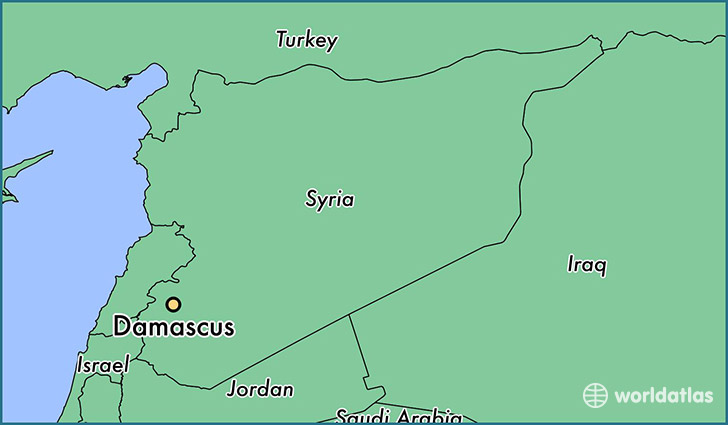Map of Damascus- Syria

Damascus is the capital and likely the largest city of Syria, following the decline in population of Aleppo due to the ongoing battle for the city. It is commonly known in Syria as ash-Sham and nicknamed as the City of Jasmine. In addition to being one of the oldest continuously inhabited cities in the world, Damascus is a major cultural and religious centre of the Levant. The city has an estimated population of 1,711,000 as of 2009.
Located in south-western Syria, Damascus is the centre of a large metropolitan area of 2.6 million people (2004). Geographically embedded on the eastern foothills of the Anti-Lebanon mountain range 80 kilometres (50 mi) inland from the eastern shore of the Mediterranean on a plateau 680 metres (2,230 ft) above sea level, Damascus experiences a semi-arid climate because of the rain shadow effect. The Barada River flows through Damascus.
First settled in the second millennium BC, it was chosen as the capital of the Umayyad Caliphate from 661 to 750. After the victory of the Abbasid dynasty, the seat of Islamic power was moved to Baghdad. Damascus saw a political decline throughout the Abbasid era, only to regain significant importance in the Ayyubid and Mamluk periods. Today, it is the seat of the central government and all of the government ministries.
Population
Damascus is the second largest city in Syria, with a population of 1,711,000 (estimate, 2009). It holds the record as the oldest continually inhabited city in the world – there is evidence of human habitation in Damascus dating back to 9,000 BC.
Language
Modern Standard Arabic is the language of education, but is not native to anyone. At home, most Syrians speak dialects of Levantine Arabic, specifically South Syrian Arabic, spoken in the cities of Damascus, Homs and Hama, and Tartous, and North Syrian Arabic, spoken in the region of Aleppo.
Currency
The currency used in Syria is the Syrian pound (SYP),(or lira).
Geography
Damascus was built in a strategic site on a plateau above sea level and about 80 km (50 mi) inland from the Mediterranean, sheltered by the Anti-Lebanon mountains, supplied with water by the Barada River, and at a crossroads between trade routes: the north-south route connecting Egypt with Asia Minor, and the east-west cross-desert route connecting Lebanon with the Euphrates river valley. The Anti-Lebanon mountains mark the border between Syria and Lebanon. The range has peaks of over 10,000 ft. and blocks precipitation from the Mediterranean sea, so that the region of Damascus is sometimes subject to droughts. However, in ancient times this was mitigated by the Barada River, which originates from mountain streams fed by melting snow. Damascus is surrounded by the Ghouta, irrigated farmland where many vegetables, cereals and fruits have been farmed since ancient times. Maps of Roman Syria indicate that the Barada river emptied into a lake of some size east of Damascus. Today it is called Bahira Atayba, the hesitant lake, because in years of severe drought it does not even exist.
The modern city has an area of 105 km2 (41 sq mi), out of which 77 km2 (30 sq mi) is urban, while Jabal Qasioun occupies the rest.
The old city of Damascus, enclosed by the city walls, lies on the south bank of the river Barada which is almost dry (3 cm (1 in) left). To the south-east, north and north-east it is surrounded by suburban areas whose history stretches back to the Middle Ages: Midan in the south-west, Sarouja and Imara in the north and north-west. These neighbourhoods originally arose on roads leading out of the city, near the tombs of religious figures. In the 19th century outlying villages developed on the slopes of Jabal Qasioun, overlooking the city, already the site of the al-Salihiyah neighbourhood centred on the important shrine of Sheikh Muhi al-Din ibn Arabi. These new neighbourhoods were initially settled by Kurdish soldiery and Muslim refugees from the European regions of the Ottoman Empire which had fallen under Christian rule. Thus they were known as al-Akrad (the Kurds) and al-Muhajirin (the migrants). They lay 2–3 km (1–2 mi) north of the old city.
From the late 19th century on, a modern administrative and commercial centre began to spring up to the west of the old city, around the Barada, centred on the area known as al-Marjeh or the meadow. Al-Marjeh soon became the name of what was initially the central square of modern Damascus, with the city hall on it. The courts of justice, post office and railway station stood on higher ground slightly to the south. A Europeanised residential quarter soon began to be built on the road leading between al-Marjeh and al-Salihiyah. The commercial and administrative centre of the new city gradually shifted northwards slightly towards this area.
In the 20th century, newer suburbs developed north of the Barada, and to some extent to the south, invading the Ghouta oasis. In 1956–1957 the new neighbourhood of Yarmouk became a second home to thousands of Palestinian refugees. City planners preferred to preserve the Ghouta as far as possible, and in the later 20th century some of the main areas of development were to the north, in the western Mezzeh neighbourhood and most recently along the Barada valley in Dummar in the north west and on the slopes of the mountains at Berze in the north-east. Poorer areas, often built without official approval, have mostly developed south of the main city.
Damascus used to be surrounded by an oasis, the Ghouta region, watered by the Barada river. The Fijeh spring, west along the Barada valley, used to provide the city with drinking water. The Ghouta oasis has been decreasing in size with the rapid expansion of housing and industry in the city and it is almost dry. It has also become polluted due to the city’s traffic, industry, and sewage.
Climate
Damascus has a cold semi-arid climate (BSk) in Köppen-Geiger system, due to the rain shadow effect of the Anti-Lebanon Mountains and the prevailing ocean currents. Summers are dry and hot with less humidity. Winters are cool and somewhat rainy; snowfall is infrequent. Annual rainfall is around 130 mm (5 in), occurring from October to May.
Economy
The historical role that Damascus played as an important trade center has changed in recent years due to political development in the region as well as the development of modern trade. Most goods produced in Damascus, as well as in Syria, are distributed to countries of the Arabian peninsula. Damascus has also held an annual international trade exposition every fall, since 1955.
The tourism industry in Damascus has a lot of potential, however the current civil war has hampered these prospects. The abundance of cultural wealth in Damascus has been modestly employed since the late 1980s with the development of many accommodation and transportation establishments and other related investments. Since the early 2000s, numerous boutique hotels and bustling cafes opened in the old city which attract plenty of European tourists and Damascenes alike.
In 2009 new office space was built and became available on the real estate market. The real-estate sector is stopped due to the terrorism and exodus of the population. Damascus is home to a wide range of industrial activity, such as textile, food processing, cement and various chemical industries. The majority of factories are run by the state, however limited privatization in addition to economic activities led by the private sector, were permitted starting in the early 2000s with the liberalization of trade that took place. Traditional handcrafts and artisan copper engravings are still produced in the old city.
The Damascus stock exchange formally opened for trade in March 2009, and the exchange is the only stock exchange in Syria. It is currently located in the Barzeh district, within Syria’s financial markets and securities commission. Its final home is to be the upmarket business district of Yaafur.
Religion
Islam is the dominant religion. The majority of Muslims are Sunni while Alawites and Twelver Shi’a comprise sizeable minorities. Alawites live primarily in the Mezzeh districts of Mezzeh 86 and Sumariyah. Twelvers primarily live near the Shia holy sites of Sayyidah Ruqayya and Sayyidah Zaynab. It is believed that there are more than 200 mosques in Damascus, the most well-known being the Umayyad Mosque. Christians represent about 15%–20% of the population. Several Eastern Christian rites have their headquarters in Damascus. The Christian districts in the city are Bab Tuma, Qassaa and Ghassani. Each have many churches, most notably the ancient Chapel of Saint Paul. At the suburb Soufanieh a series of apparitions of the Virgin Mary have reportedly been observed between 1982 and 2004. A smaller Druze minority inhabits the city, notably in the mixed Christian-Druze suburbs of Tadamon, Jaramana, and Sahnaya. The Supreme Church of Syrian Orthdox is based in Damascus, Bab Toma. This church is independent of the Middle Eastern-based Syriac Orthodox Church in Damascus and has its own leadership and structure in India, although both practice the same or similar denomination of Christianity. There are 170,000 Syriac Orthodox members in Syria.
There was a small Jewish community namely in what is called Haret al-Yahud the Jewish quarter. They are the remnants of an ancient and much larger Jewish presence in Syria, dating back at least to Roman times, if not before to the time of King David.
Sufism
Sufism throughout the second half of the 20th century has been an influential current in the Sunni religious practises, particularly in Damascus. The largest women-only and girls-only Muslim movement in the world happens to be Sufi-oriented and is based in Damascus, led by Munira al-Qubaysi. Syrian Sufism has its stronghold in urban regions such as Damascus, where it also established political movements such as Zayd, with the help of a series of mosques, and clergy such as Abd al-Ghani al-Nabulsi, Sa’id Hawwa, Abd al-Rahman al-Shaghouri and Muhammad al-Yaqoubi.
Culture
Damascus was chosen as the 2008 Arab Capital of Culture. The preparation for the festivity began in February 2007 with the establishing of the Administrative Committee for “Damascus Arab Capital of Culture” by a presidential decree.
Transportation
The main airport is Damascus International Airport, approximately 20 km (12 mi) away from the city, with connections to a few Middle Eastern cities. Before the beginning of the Syrian civil war, the Airport had connectivity to many Asian, European, African, and, South American cities. Streets in Damascus are often narrow, especially in the older parts of the city, and speed bumps are widely used to limit the speed of vehicles.
Public transport in Damascus depends extensively on minibuses. There are about one hundred lines that operate inside the city and some of them extend from the city center to nearby suburbs. There is no schedule for the lines, and due to the limited number of official bus stops, buses will usually stop wherever a passenger needs to get on or off. The number of buses serving the same line is relatively high, which minimizes the waiting time. Lines are not numbered, rather they are given captions mostly indicating the two end points and possibly an important station along the line and Taxicab.
Served by Chemins de Fer Syriens, the former main railway station of Damascus was al-Hejaz railway station, about 1 km (5⁄8 mi) west of the old city. The station is now defunct and the tracks have been removed, but there still is a ticket counter and a shuttle to Damacus Kadam station in the south of the city, which now functions as the main railway station.
In 2008, the government announced a plan to construct a Damascus Metro with opening time for the green line scheduled for 2015. The green line will be an essential West-East axis for the future public transportation network, serving Moadamiyeh, Sumariyeh, Mezzeh, Damascus University, Hijaz, the Old City, Abbassiyeen and Qaboun Pullman bus station. A four-line metro network is expected be in operation by 2050.










